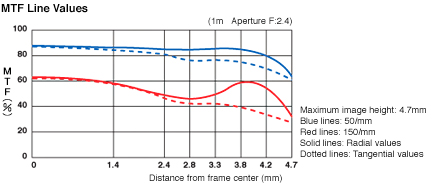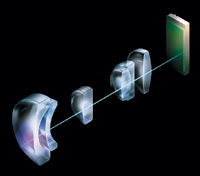Inside Story
High definition despite miniaturization - GR lens design.
“I couldn't stop thinking about what the GR lens should be like”, says Tsurukawa. “I couldn't get the GR out of my head. I took the opinions of professional users on board, and tried to reach the specifications they need.” Very specialized design, in terms of aspects like manufacturing methods and lens construction, ets. is necessary for turning the abstract concept of “high quality picture” into reality.
“In a nutshell, this is a high definition lens which reduces aberrations right into the fringes”, says Saito. “High definition” refers to the ability of the lens to collect the maximum light information from the subject illustrated by MTF curves. The ability to distinguish between black parallel lines in a 1mm space is expressed in terms of “lines/mm”. If the definition is low, separate black lines cannot be distinguished and they appear as a gray mass. This would mean that each individual hair would not be visible and the image would appear fudged.
The lens development team used the MTF method of lens definition measurement to advance the project. They formed the lens by examining MTF curves on a daily basis.

- *MTF - Modulation Transfer Function. A method of measuring lens performance. The more horizontal the curve the higher the contrast at the periphery. The more the curve drops to the right the lower the contrast at the periphery.
“We set ourselves the concrete aim of producing a lens which gives almost the same brightness and definition both in the center of the image and around the edges,” says Saito.
A lens which projects all the light accurately

Aberration is reduced to a minimum
through perfect alignment of the axes of
the lenses, giving a clear and sharp
image.
What exactly is an “aberration”? A rainbow proves that there are many colors within the white light in the sky. Because the different colors have different wavelengths, when the sunlight is reflected by raindrops falling through the air, it appears to the human eye as a rainbow. The same is true for a camera lens. If different colored light fragments with different wavelengths fall on to different parts of the CCD, this will have an effect on the colors of the final image. “This is known as color aberration, and it always happens in the periphery of the picture. Another kind of aberration is when round objects in the periphery of the picture appear to be elongated,” Saito explains. “We tried to produce a lens which would reduce these aberrations as much as possible, giving the same quality both in the center of the image and around the edges, without distortions and unnatural colors”.
However, in order to achieve this, extreme precision was essential, and absolutely no inaccuracies could be tolerated. “This would have been impossible using traditional lens cell production methods”, said Tsurukawa. “It would be easier to do it as a fixed lens group, but because it had to be compact, a retractable lens group stored in a lens cell was chosen. It is no mean feat to achieve high picture quality right up to the edges of the image with this system. Even if you can do it in theory, it is no use unless you can actually manufacture it. Being able to develop lens axis alignment technology alongside the development of the GR lens meant we were able to get over these hurdles. It was then that we were sure that we would be able to produce a compact version of the GR lens!”
By optimizing the positioning of the concave and convex lenses, it is possible to reduce the number of lenses in the group, thus improving light penetration. Furthermore, the axes are aligned to the last micron in each camera, thus ensuring even picture quality right into the corner of the image. This is how the GR lens was born, its very fast lens speed of F2.4, a high performance 28mm* equivalent wide angle, and high resolution right into the corner of the image.
- *Converted to 35mm format


